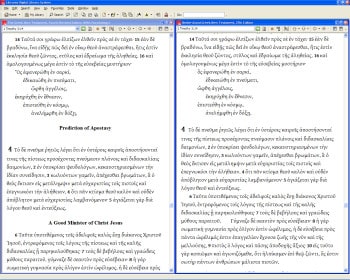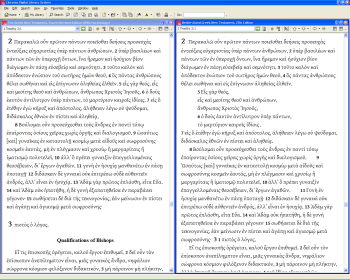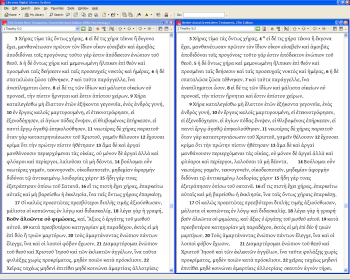If you’ve looked at the list of Greek New Testaments contained in Scholar’s Library (and Silver, and Gold) in any detail, you’ve likely noticed that both the UBS4 and NA27 texts are included.
I’m sure you’re asking, “Hey, aren’t those the same text? Why would you ever have them both?”
It’s true, the texts share great similarity and can even be said to be the same text. From tha NA27 Introduction:
The text of this edition reproduces that of the 26th edition unchanged. Consequently, with rare exceptions, the paragraphing and punctuation remains the same, avoiding the necessity for altering the page makeup. Thus the text of the present edition is identical as before with that of The Greek New Testament, now in its 4th revised edition. The same text underlies the concordances, the Lexikon zum Neuen Testament, and the Synopsis quattuor Evangeliorum.
Nestle, E., Nestle, E., Aland, K., Aland, B., & Universität Münster. Institut für Neutestamentliche Textforschung. (1993, c1979). Novum Testamentum Graece. At head of title: Nestle-Aland. (27. Aufl., rev.). Stuttgart: Deutsche Bibelstiftung.
But an edition is more than text. The NA27 and UBS4 editions have the same letters in the same order with the same book, chapter and verse breaks. But that’s where the similarity ends. The texts have different punctuation, different casing, different paragraph breaks, different ideas of what constitute quotes or allusions from the Old Testament, and different poetry formatting.
All of these features play in to how a text is read and understood—you know, the very thing that students of the Greek New Testament (and the Bible in general) are very interested in.
Because Logos preserves as much formatting of the printed edition of the text as possible, these differences can be seen in comparisons of the text. One good example that has exegetical implications is found in 1Ti 3.16. This is a well known verse that contains what may be an early hymn or creed that the author used to support his argument. Some commentators see 1Ti 3.14-16 as the central piece of the epistle. But NA27 and UBS4 format the poetry/creed/hymn differently. UBS4 has the six lines formatted as two triplets while NA27 formats the text as three doublets.
Click image for larger graphic
The formatting has direct impact on how one reads the text. Are there two groups of three things? Or three groups of two things? What items are parallel to each other? Each edition presents different options, so both are necessary to consult to get a clear picture of the problem.
Sometimes one text will format things as poetry when another does not. An example of this is found in 1Ti 2.1-7. The UBS4 text sees this whole block as one paragraph, while the NA27 breaks out verses 5 and 6 as poetry (or perhaps an early hymn or creed or saying of some sort).
Click image for larger graphic
If one considers vv 5-6 as a reference to an early creedal statement, it may play a different role in exegesis than normal supporting text in prose. There are a few options. From the NA27 text, one might conclude that Paul is either waxing poetic/creedal (very possible) or referring to a commonly known creedal statement to back up his statement in vv. 3-4 (God wants to save all people, and wants them all to come into knowledge of the truth). Or, reading from the UBS4 text, one might consider vv 5-6 to be normal prose offered in support of the previous assertion with no creedal sort of impact. Is Paul appealing to an external saying he knows his audience will see as authoritative? Or is he being creative? Or did he just come up with some nice phraseology in the context of his argument? All (and more!) are possible. Whichever you prefer, the typography of each edition conveys the editors’ thoughts and it is valuable to take into account when reading and exegeting the text.
Another difference between editions is when one text has more paragraph breaks than the other. A good example of this is found in 1Ti 5.3-16. In the UBS4 text, this is one paragraph. In the NA27 text, it is two paragraphs (vv 3-8 and vv 9-16) with a sub-paragraph break in the second paragraph (so sub-paragraphs of vv 9-13 and vv 14-16). UBS4 has no notion of sub-paragraph breaks, but the NA27 uses them routinely to break larger paragraphs. You can see another one in the screen shot before verse 21.
Click image for larger graphic
A few other slight differences between versions can be seen in the above screen capture.
First, note the word Σατανᾶ in verse 15 of UBS4. The same term is σατανᾶ in the NA27. One could conclude that the UBS4 edition considers this to be a name or title, while the NA27 edition considers it a noun (“adversary”). This is not a small difference when it comes to exegesis.
Second, note the quotations and allusions from the Old Testament in vv. 17-19. They’re different typographically. UBS4 uses bold font while NA27 uses an italic font. But if you look closely, you’ll see disagreement on what is and is not a quotation from or allusion to the Old Testament. The UBS4 is much more conservative here; it generally only emboldens fairly direct quotations. The NA27, on the other hand, notes both quotations (the one matching the UBS4 edition) and allusions (the balance of italic text in vv 18-20. This as well is exegetically significant. If I think the author is reaching back to quote or allude to the Old Testament in the course of his argument, it may affect exegesis of the text.
The bottom line: While UBS4 and NA27 do share the same sequence of letters, they differ in many, many other ways. They are different editions of the same text. Some of these differences can and do affect exegesis. I’ve used examples from the same relatively short epistle (First Timothy, six chapters long) on purpose so you can see these differences can and do occur with frequency.
They are not isolated.
The good news is that your Logos Bible Software presents these texts as they appear in their printed versions. The UBS4 text even has section heads and, in the gospels, cross-references after the headings to parallel passages. You can simply scroll the text side-by-side to see if there are any differences in the passage you’re studying.
When you run across differences, ask yourself: “What impact would this difference have on exegesis of the text? What would I have missed if I wouldn’t have noticed this?” and seriously think about the options. Your exegesis will be better for it.







